土耳其英文介绍资料讲解32页PPT
- 格式:ppt
- 大小:3.59 MB
- 文档页数:32

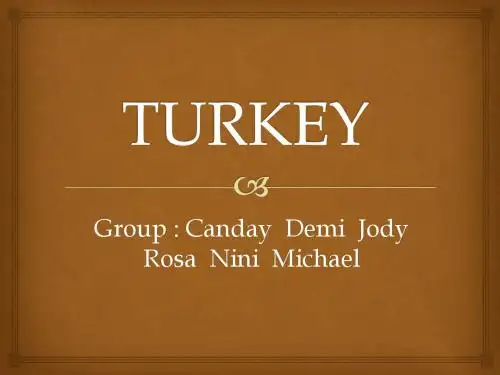
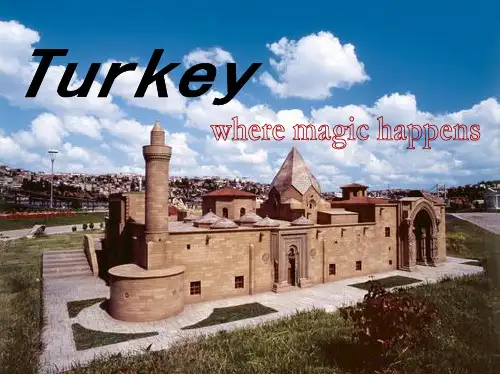
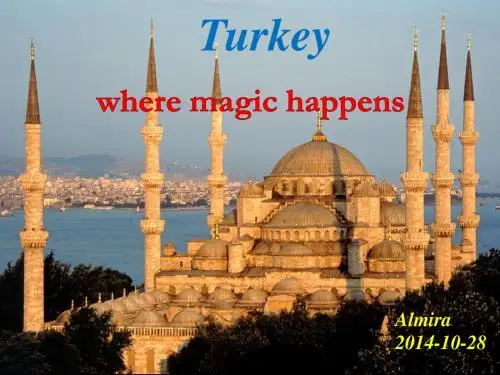
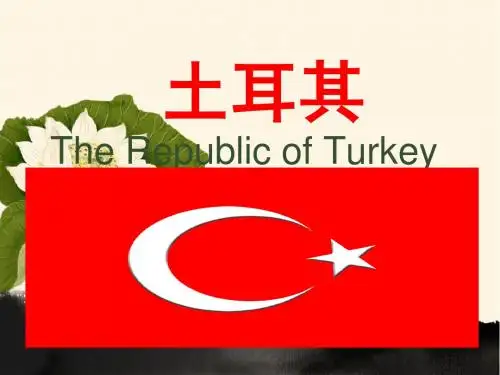
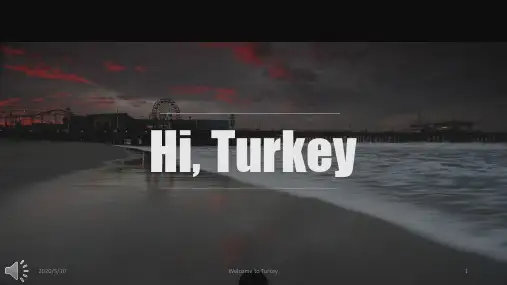
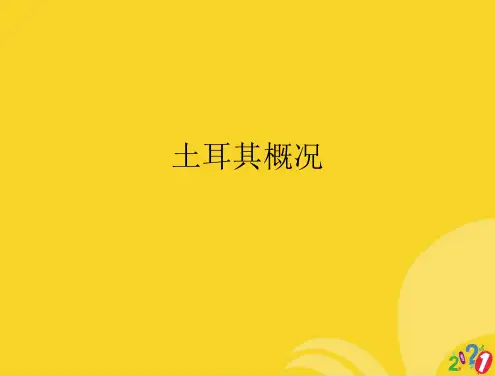

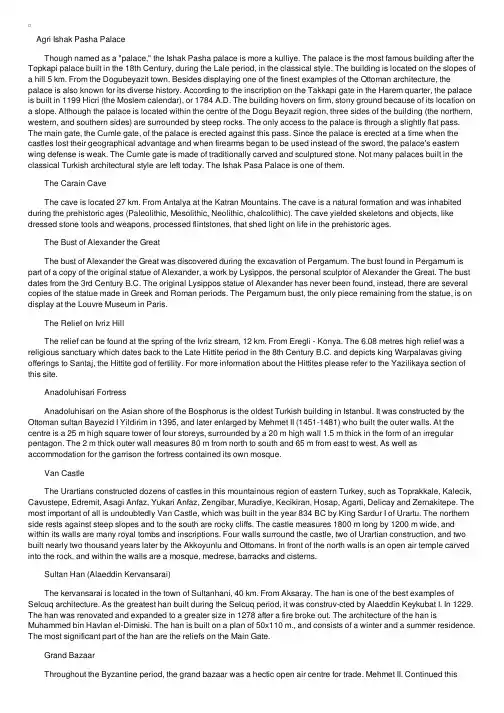
Agri Ishak Pasha Palace Though named as a "palace," the Ishak Pasha palace is more a kulliye. The palace is the most famous building after the Topkapi palace built in the 18th Century, during the Lale period, in the classical style. The building is located on the slopes of a hill 5 km. From the Dogubeyazit town. Besides displaying one of the finest examples of the Ottoman architecture, the palace is also known for its diverse history. According to the inscription on the Takkapi gate in the Harem quarter, the palace is built in 1199 Hicri (the Moslem calendar), or 1784 A.D. The building hovers on firm, stony ground because of its location on a slope. Although the palace is located within the centre of the Dogu Beyazit region, three sides of the building (the northern, western, and southern sides) are surrounded by steep rocks. The only access to the palace is through a slightly flat pass. The main gate, the Cumle gate, of the palace is erected against this pass. Since the palace is erected at a time when the castles lost their geographical advantage and when firearms began to be used instead of the sword, the palace's eastern wing defense is weak. The Cumle gate is made of traditionally carved and sculptured stone. Not many palaces built in the classical Turkish architectural style are left today. The Ishak Pasa Palace is one of them. The Carain Cave The cave is located 27 km. From Antalya at the Katran Mountains. The cave is a natural formation and was inhabited during the prehistoric ages (Paleolithic, Mesolithic, Neolithic, chalcolithic). The cave yielded skeletons and objects, like dressed stone tools and weapons, processed flintstones, that shed light on life in the prehistoric ages. The Bust of Alexander the Great The bust of Alexander the Great was discovered during the excavation of Pergamum. The bust found in Pergamum is part of a copy of the original statue of Alexander, a work by Lysippos, the personal sculptor of Alexander the Great. The bust dates from the 3rd Century B.C. The original Lysippos statue of Alexander has never been found, instead, there are several copies of the statue made in Greek and Roman periods. The Pergamum bust, the only piece remaining from the statue, is on display at the Louvre Museum in Paris. The Relief on Ivriz Hill The relief can be found at the spring of the Ivriz stream, 12 km. From Eregli - Konya. The 6.08 metres high relief was a religious sanctuary which dates back to the Late Hittite period in the 8th Century B.C. and depicts king Warpalavas giving offerings to Santaj, the Hittite god of fertility. For more information about the Hittites please refer to the Yazilikaya section of this site. Anadoluhisari Fortress Anadoluhisari on the Asian shore of the Bosphorus is the oldest Turkish building in Istanbul. It was constructed by the Ottoman sultan Bayezid I Yildirim in 1395, and later enlarged by Mehmet II (1451-1481) who built the outer walls. At the centre is a 25 m high square tower of four storeys, surrounded by a 20 m high wall 1.5 m thick in the form of an irregular pentagon. The 2 m thick outer wall measures 80 m from north to south and 65 m from east to west. As well as accommodation for the garrison the fortress contained its own mosque. Van Castle The Urartians constructed dozens of castles in this mountainous region of eastern Turkey, such as Toprakkale, Kalecik, Cavustepe, Edremit, Asagi Anfaz, Yukari Anfaz, Zengibar, Muradiye, Kecikiran, Hosap, Agarti, Delicay and Zernakitepe. The most important of all is undoubtedly Van Castle, which was built in the year 834 BC by King Sardur I of Urartu. The northern side rests against steep slopes and to the south are rocky cliffs. The castle measures 1800 m long by 1200 m wide, and within its walls are many royal tombs and inscriptions. Four walls surround the castle, two of Urartian construction, and two built nearly two thousand years later by the Akkoyunlu and Ottomans. In front of the north walls is an open air temple carved into the rock, and within the walls are a mosque, medrese, barracks and cisterns. Sultan Han (Alaeddin Kervansarai) The kervansarai is located in the town of Sultanhani, 40 km. From Aksaray. The han is one of the best examples of Selcuq architecture. As the greatest han built during the Selcuq period, it was construv-cted by Alaeddin Keykubat I. In 1229. The han was renovated and expanded to a greater size in 1278 after a fire broke out. The architecture of the han is Muhammed bin Havlan el-Dimiski. The han is built on a plan of 50x110 m., and consists of a winter and a summer residence. The most significant part of the han are the reliefs on the Main Gate. Grand Bazaar Throughout the Byzantine period, the grand bazaar was a hectic open air centre for trade. Mehmet II. Continued thistradition but added two covered bedesten (the older version of the modern shopping malls today). The bazaar extended to an even greater scale by Suleyman I. (1520-1566). The last additions of bedesten shops in the bazaar were made in 1701. Misir Carsisi (Egyptian Bazaar) The Egyptian Bazaar (Misir Carsisi) It is the second covered bazaar of Istan- bul. Was built during the era of Mehmet IV, in compliance with the request of Queen Mother Hatice Turhan. Built in 1660 by the architect Kasim Aga as part of the Yeni Camii Mosque Complex, the bazaar lies today next to the mosque. The bazaar has an 'L' shape with six gates and 86 shops operating in the bazaar today. Kizkalesi The Castle of Korykos on shore faces another fort, Kizkalesi (Maiden's Castle), that stands on a tiny island 200 meters offshore. Formerly a sea wall joined the two fortresses. The Maiden's Castle is located 60 km. From Mersin, near the Erdemli town. It is assumed that the castle originally had a road connecting the castle to the mainland. The road eroded with time and the the castle remains separated from the mainland. The Maiden's Castle, together with the Castle of Korykos, were built in the IV. Century B.C. by the Greek settlers to prevent assaults to the city of Korykos from the sea. The city of Korykos remained an important harbour in Southeastern Meditteranean until the XIII. Century A.D. The castle passed into Turkish hands when it was conquered by Ibrahim Bey of the Karamanoglu Principality in 1448 and was extensively renovated. The castle has a circumference of 900 m and eight towers.。
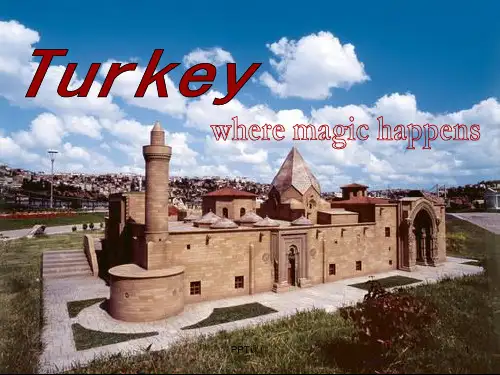
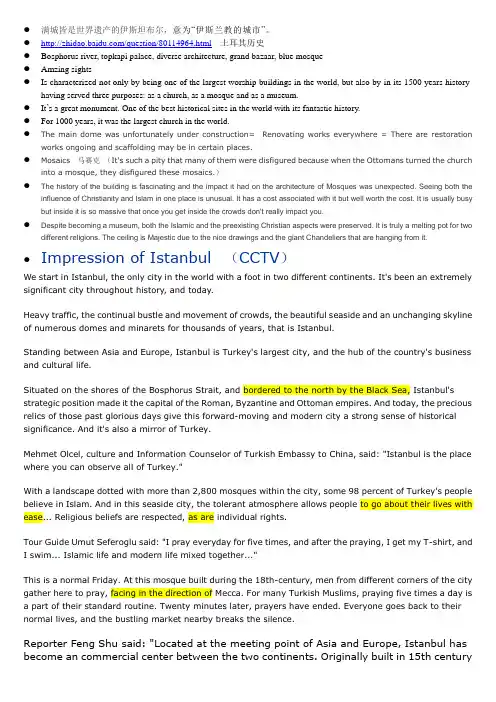
●满城皆是世界遗产的伊斯坦布尔,意为“伊斯兰教的城市”。
●/question/80114964.html土耳其历史●Bosphorus river, topkapi palace, diverse architecture, grand bazaar, blue mosque●Amzing sights●Is characterized not only by being one of the largest worship buildings in the world, but also by-in its 1500 years history-having served three purposes: as a church, as a mosque and as a museum.●It’s a great monument. One of the best historical sites in the world with its fantastic history.●For 1000 years, it was the largest church in the world.●The main dome was unfortunately under construction= Renovating works everywhere = There are restorationworks ongoing and scaffolding may be in certain places.●Mosaics 马赛克(It's such a pity that many of them were disfigured because when the Ottomans turned the churchinto a mosque, they disfigured these mosaics.)●The history of the building is fascinating and the impact it had on the architecture of Mosques was unexpected. Seeing both theinfluence of Christianity and Islam in one place is unusual. It has a cost associated with it but well worth the cost. It is usually busy but inside it is so massive that once you get inside the crowds don't really impact you.●Despite becoming a museum, both the Islamic and the preexisting Christian aspects were preserved. It is truly a melting pot for twodifferent religions. The ceiling is Majestic due to the nice drawings and the giant Chandeliers that are hanging from it.●Impression of Istanbul (CCTV)We start in Istanbul, the only city in the world with a foot in two different continents. It's been an extremely significant city throughout history, and today.Heavy traffic, the continual bustle and movement of crowds, the beautiful seaside and an unchanging skyline of numerous domes and minarets for thousands of years, that is Istanbul.Standing between Asia and Europe, Istanbul is Turkey's largest city, and the hub of the country's business and cultural life.Situated on the shores of the Bosphorus Strait, and bordered to the north by the Black Sea, Istanbul's strategic position made it the capital of the Roman, Byzantine and Ottoman empires. And today, the precious relics of those past glorious days give this forward-moving and modern city a strong sense of historical significance. And it's also a mirror of Turkey.Mehmet Olcel, culture and Information Counselor of Turkish Embassy to China, said: "Istanbul is the place where you can observe all of Turkey."With a landscape dotted with more than 2,800 mosques within the city, some 98 percent of Turkey's people believe in Islam. And in this seaside city, the tolerant atmosphere allows people to go about their lives with ease... Religious beliefs are respected, as are individual rights.Tour Guide Umut Seferoglu said: "I pray everyday for five times, and after the praying, I get my T-shirt, and I swim... Islamic life and modern life mixed together..."This is a normal Friday. At this mosque built during the 18th-century, men from different corners of the city gather here to pray, facing in the direction of Mecca. For many Turkish Muslims, praying five times a day is a part of their standard routine. Twenty minutes later, prayers have ended. Everyone goes back to their normal lives, and the bustling market nearby breaks the silence.Reporter Feng Shu said: "Located at the meeting point of Asia and Europe, Istanbul has become an commercial center between the two continents. Originally built in 15th centurywith only 15-20 shops, this Grand Bazaar has become a real shopping heaven with 4,400 shops. Well, of course, my favorite place in Turkey."Shopping in Istanbul is a time-honored delight. In the labyrinth of 65 streets and passages in this Kapali Carsi-covered bazaar, a plethora of goods are available, enough to suit nearly every taste. There's a wide selection of jewelry, from traditional to modern styles, while the carpet shops display eye-catching wares with vivid colors and intricate designs. At the same time, Turkish arts and crafts, including hand-painted ceramic plates andhand-crafted copperware, are all popular choices for souvenirs and gifts.And for sellers, getting a space this bazaar means steady and booming business.A seller said: "This bazaar is much better, more famous than other shops."A tour guide said: "This bazaar has a mystical atmosphere."With Istanbul an important commercial city, the Grand Bazaar is not the only option for shoppers... Another attractive, covered bazaar of a different sort is the Misir Carsisi, or the Spice Market, located at the entrance of Golden Horn. At this market, built in the17th-century, the air is filled with the enticing aromas of cinnamon, caraway, mint and countless other spices and herbs.Despite the different choices, the two bazaars share something in common -- most of the dealers are international. English, Japanese, and even Chinese and more are at their command. For travellers without any knowledge of the Turkish language, it's a good place to find yourself.Geographically, Istanbul is flanked by a range of high hills to the east to the Bosphorus Strait.Because of this unique location, most of Istanbul's streets are on sharp slopes. They're so steep, you have to be careful not to fall down when climbing up.Any trip to Istanbul isn't complete without a ferry excursion along the Bosphorus Strait. Along its shores is a delightfully surprising mixture of the past and present, grand splendor and simple beauty, with imperial pavilions and palaces standing next to today's small fishing villages.The Bosphorus Bridge was built in 1973. It's still one of the longest bridges in the world, and spans the water, linking European and Asian shores by road.Under the bridge, the once-quiet village of Ortakoy, has been turned into an art gallery, a shopping destination and a bar street, a favorite place for entertainment for both tourists and locals.Church of Hagia Sophia 圣索菲亚大教堂,学名是阿亚索菲亚博物馆(Ayasofya Muzesi),是国家博物馆,它具有曲折的历史,目睹了王朝兴衰,也反映了宗教的博弈、变迁和融合,所谓“东方与西方,过去与未来相结合”;它还占据了几个“唯一”:唯一从6世纪保留至今的古代建筑、唯一一个由教堂改成清真寺的古建筑,又是世界上十大令人向往的教堂之一圣索菲亚在基督教里的意思是“上帝智慧”,公元325年,君士坦丁大帝为供奉智慧之神索非亚,建造了圣索菲亚大教堂,成为拜占廷(Byzantine)帝国极盛时代的纪念碑。
Turkey土耳其”一词由“突厥”演变而来。
在鞑靼语中,“突厥”是“勇敢”的意思,“土耳其”意即“勇敢人的国家”是一个横跨欧亚两洲的国家,国土包括西亚的安纳托利亚半岛和南欧、巴尔干半岛的东色雷斯地区土耳其地理位置和地缘政治战略意义极为重要,是连接欧亚的十字路口。
National flag The Republic of Turkey中文名称土耳其共和国英文名称The Republic of Turkey简称土耳其所属洲欧洲首都安卡拉人口数量 76,134,783(2013年)人口密度101.8人/平方公里(2013年)主要民族土耳其族主要宗教伊斯兰教国土面积78.3562万平方千米旗面为红色,靠旗杆一侧有一弯白色新月和一颗白色五角星。
红色象征鲜血和胜利;新月和星象征驱走黑暗、迎来光明。
也象征幸福和吉祥。
针织面料: 超细纤维、天鹅绒等针织面料其它面料: 人造裘皮、人造革、坯布、刺绣、拉舍尔、摩弗伦等超细纤维超细纤维是近年来发展迅速的差别化纤维的一种,被称为新一代的合成纤维,是一种高品质、高技术的纺织原料,是化学纤维向高技术、高仿真化方向发展的新合纤的典型代表。
超细纤维用途很广:用它作的织物,经砂洗、磨绒等高级整理后,表面形成一层类似桃皮茸毛的外观,并极为膨松、柔软、滑爽,用这种面料制造的高档时装、茄克、T恤衫、内衣、裙裤等凉爽舒适,吸汗不贴身,富有青春美;国外用超细纤维作成高级人造麂皮,既有酷似真皮的外观、手感、风格,又有低廉的价格;由于超细纤维又细又软,用它作成洁净布除污效果极好,可擦拭各种眼镜、影视器材、精密仪器,对镜面毫无损伤;用超细纤维还可制成表面极为光滑的超高密织物,用来制作滑雪、滑冰、游泳等运动服可减少阻力,有利于运动员创造良好成绩;此外,超细纤维还可用于过滤、医疗卫生、劳动保护等多种领域。
进口织机制成的经编毛巾布,其表面性状为均匀、紧凑、柔软、高弹的细微绒团,有极强的去污、吸水性能。
●满城皆是世界遗产的伊斯坦布尔,意为“伊斯兰教的城市”。
●/question/80114964.html土耳其历史●Bosphorus river, topkapi palace, diverse architecture, grand bazaar, blue mosque●Amzing sights●Is characterized not only by being one of the largest worship buildings in the world, but also by-in its 1500 years history-having served three purposes: as a church, as a mosque and as a museum.●It’s a great monument. One of the best historical sites in the world with its fantastic history.●For 1000 years, it was the largest church in the world.●The main dome was unfortunately under construction= Renovating works everywhere = There are restorationworks ongoing and scaffolding may be in certain places.●Mosaics 马赛克(It's such a pity that many of them were disfigured because when the Ottomans turned the churchinto a mosque, they disfigured these mosaics.)●The history of the building is fascinating and the impact it had on the architecture of Mosques was unexpected. Seeing both theinfluence of Christianity and Islam in one place is unusual. It has a cost associated with it but well worth the cost. It is usually busy but inside it is so massive that once you get inside the crowds don't really impact you.●Despite becoming a museum, both the Islamic and the preexisting Christian aspects were preserved. It is truly a melting pot for twodifferent religions. The ceiling is Majestic due to the nice drawings and the giant Chandeliers that are hanging from it.●Impression of Istanbul (CCTV)We start in Istanbul, the only city in the world with a foot in two different continents. It's been an extremely significant city throughout history, and today.Heavy traffic, the continual bustle and movement of crowds, the beautiful seaside and an unchanging skyline of numerous domes and minarets for thousands of years, that is Istanbul.Standing between Asia and Europe, Istanbul is Turkey's largest city, and the hub of the country's business and cultural life.Situated on the shores of the Bosphorus Strait, and bordered to the north by the Black Sea, Istanbul's strategic position made it the capital of the Roman, Byzantine and Ottoman empires. And today, the precious relics of those past glorious days give this forward-moving and modern city a strong sense of historical significance. And it's also a mirror of Turkey.Mehmet Olcel, culture and Information Counselor of Turkish Embassy to China, said: "Istanbul is the place where you can observe all of Turkey."With a landscape dotted with more than 2,800 mosques within the city, some 98 percent of Turkey's people believe in Islam. And in this seaside city, the tolerant atmosphere allows people to go about their lives with ease... Religious beliefs are respected, as are individual rights.Tour Guide Umut Seferoglu said: "I pray everyday for five times, and after the praying, I get my T-shirt, and I swim... Islamic life and modern life mixed together..."This is a normal Friday. At this mosque built during the 18th-century, men from different corners of the city gather here to pray, facing in the direction of Mecca. For many Turkish Muslims, praying five times a day is a part of their standard routine. Twenty minutes later, prayers have ended. Everyone goes back to their normal lives, and the bustling market nearby breaks the silence.Reporter Feng Shu said: "Located at the meeting point of Asia and Europe, Istanbul has become an commercial center between the two continents. Originally built in 15th centurywith only 15-20 shops, this Grand Bazaar has become a real shopping heaven with 4,400 shops. Well, of course, my favorite place in Turkey."Shopping in Istanbul is a time-honored delight. In the labyrinth of 65 streets and passages in this Kapali Carsi-covered bazaar, a plethora of goods are available, enough to suit nearly every taste. There's a wide selection of jewelry, from traditional to modern styles, while the carpet shops display eye-catching wares with vivid colors and intricate designs. At the same time, Turkish arts and crafts, including hand-painted ceramic plates andhand-crafted copperware, are all popular choices for souvenirs and gifts.And for sellers, getting a space this bazaar means steady and booming business.A seller said: "This bazaar is much better, more famous than other shops."A tour guide said: "This bazaar has a mystical atmosphere."With Istanbul an important commercial city, the Grand Bazaar is not the only option for shoppers... Another attractive, covered bazaar of a different sort is the Misir Carsisi, or the Spice Market, located at the entrance of Golden Horn. At this market, built in the17th-century, the air is filled with the enticing aromas of cinnamon, caraway, mint and countless other spices and herbs.Despite the different choices, the two bazaars share something in common -- most of the dealers are international. English, Japanese, and even Chinese and more are at their command. For travellers without any knowledge of the Turkish language, it's a good place to find yourself.Geographically, Istanbul is flanked by a range of high hills to the east to the Bosphorus Strait.Because of this unique location, most of Istanbul's streets are on sharp slopes. They're so steep, you have to be careful not to fall down when climbing up.Any trip to Istanbul isn't complete without a ferry excursion along the Bosphorus Strait. Along its shores is a delightfully surprising mixture of the past and present, grand splendor and simple beauty, with imperial pavilions and palaces standing next to today's small fishing villages.The Bosphorus Bridge was built in 1973. It's still one of the longest bridges in the world, and spans the water, linking European and Asian shores by road.Under the bridge, the once-quiet village of Ortakoy, has been turned into an art gallery, a shopping destination and a bar street, a favorite place for entertainment for both tourists and locals.Church of Hagia Sophia 圣索菲亚大教堂,学名是阿亚索菲亚博物馆(Ayasofya Muzesi),是国家博物馆,它具有曲折的历史,目睹了王朝兴衰,也反映了宗教的博弈、变迁和融合,所谓“东方与西方,过去与未来相结合”;它还占据了几个“唯一”:唯一从6世纪保留至今的古代建筑、唯一一个由教堂改成清真寺的古建筑,又是世界上十大令人向往的教堂之一圣索菲亚在基督教里的意思是“上帝智慧”,公元325年,君士坦丁大帝为供奉智慧之神索非亚,建造了圣索菲亚大教堂,成为拜占廷(Byzantine)帝国极盛时代的纪念碑。